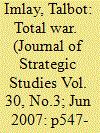|
|
|
Sort Order |
|
|
|
Items / Page
|
|
|
|
|
|
|
| Srl | Item |
| 1 |
ID:
174948


|
|
|
|
|
| Summary/Abstract |
In February 1941 Life magazine published “The American Century.” Written by Henry Luce, the media mogul and Life’s owner, the article has become a referential document—the clearest expression perhaps of the United States’ mid-twentieth century claim to global leadership. In the article, Luce invoked a pantheon of well-known people, including Roosevelt, Churchill, Hitler, Lenin, Hoover, and Coolidge. Even the Dalai Lama got a mention, as did Genghis Khan (twice). But only one non-leader figured on the list: Clarence Streit. A New York Times correspondent in Geneva during the 1930s, Streit in 1939 had published Union Now, a book-length proposal for the creation of a federal union of the North Atlantic democracies modeled on the American constitution. For Streit, the “more perfect Union” forged in 1787 in which the thirteen American states had agreed to endow the federal government with exclusive authority over a limited number of areas, should now be applied on a transatlantic scale.
|
|
|
|
|
|
|
|
|
|
|
|
|
|
|
|
| 2 |
ID:
079240


|
|
|
|
|
| Publication |
2007.
|
| Summary/Abstract |
This article reviews the five volume series, published by Cambridge University Press, on the history of total war from the American Civil War and Wars of German Unification to World War II. The discussion focuses on two questions: how to define total war; and is total war a useful conceptual tool for understanding warfare during this period? Although the editors were unable to come up with a definition of total war, they did identify elements or tendencies that together contributed to the growing totalization of war during the nineteenth and especially twentieth centuries. Regarding the second question, the editors suggest that total war is best thought of as an ideal type, one to which reality can approach but never reach. If this use of total war facilitates comparison between wars (and different aspects of one war) by providing a common standard, it leaves open the question of how to undertake such a comparison.
|
|
|
|
|
|
|
|
|
|
|
|
|
|
|
|
|
|
|
|
|